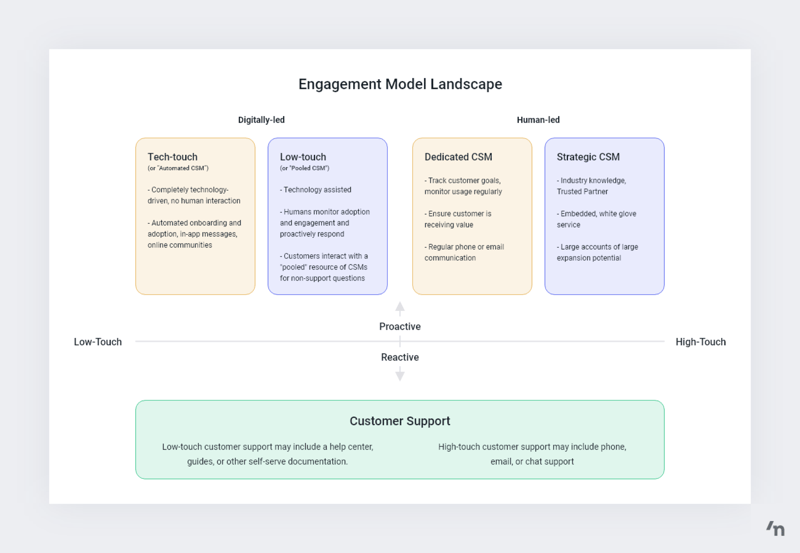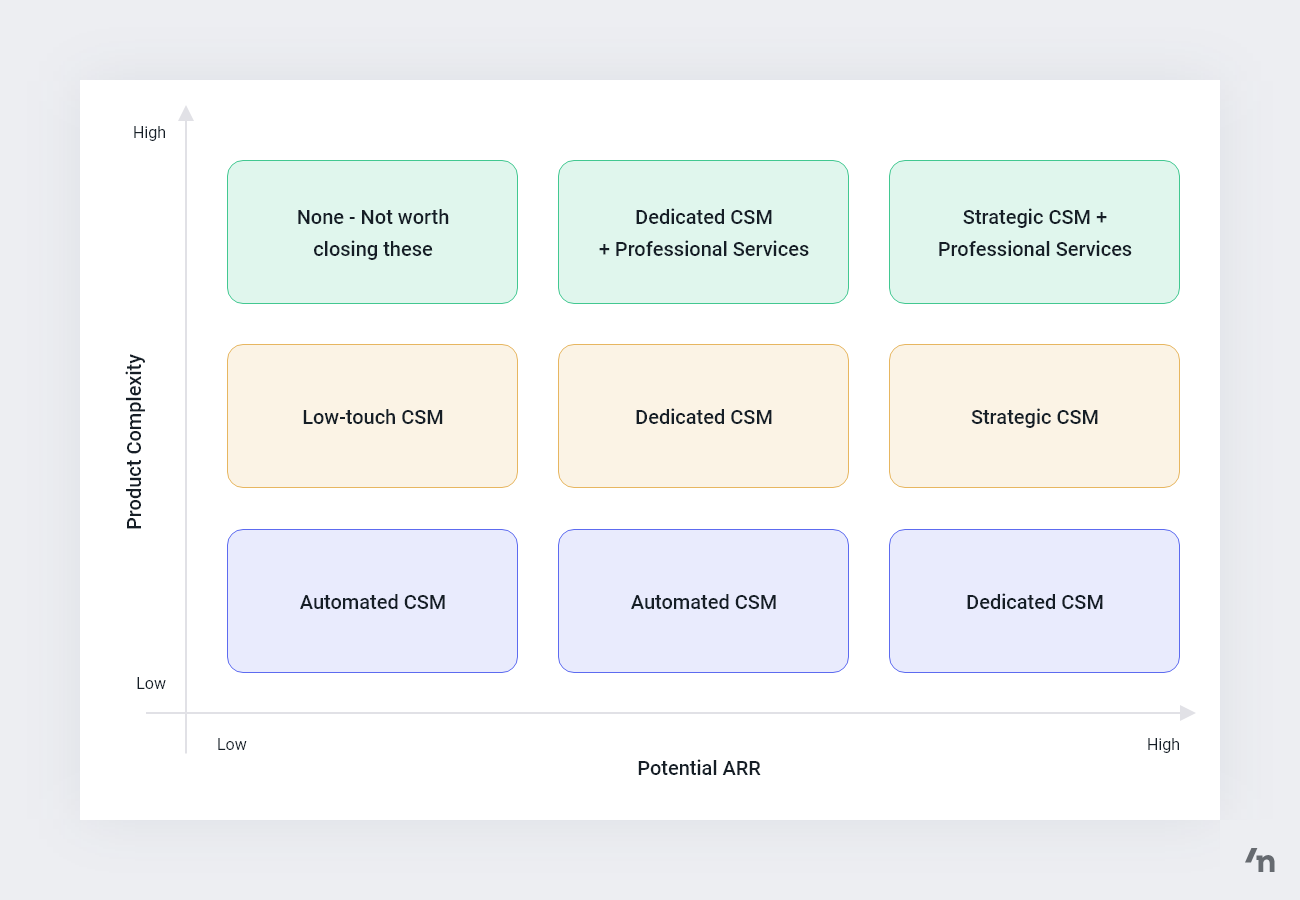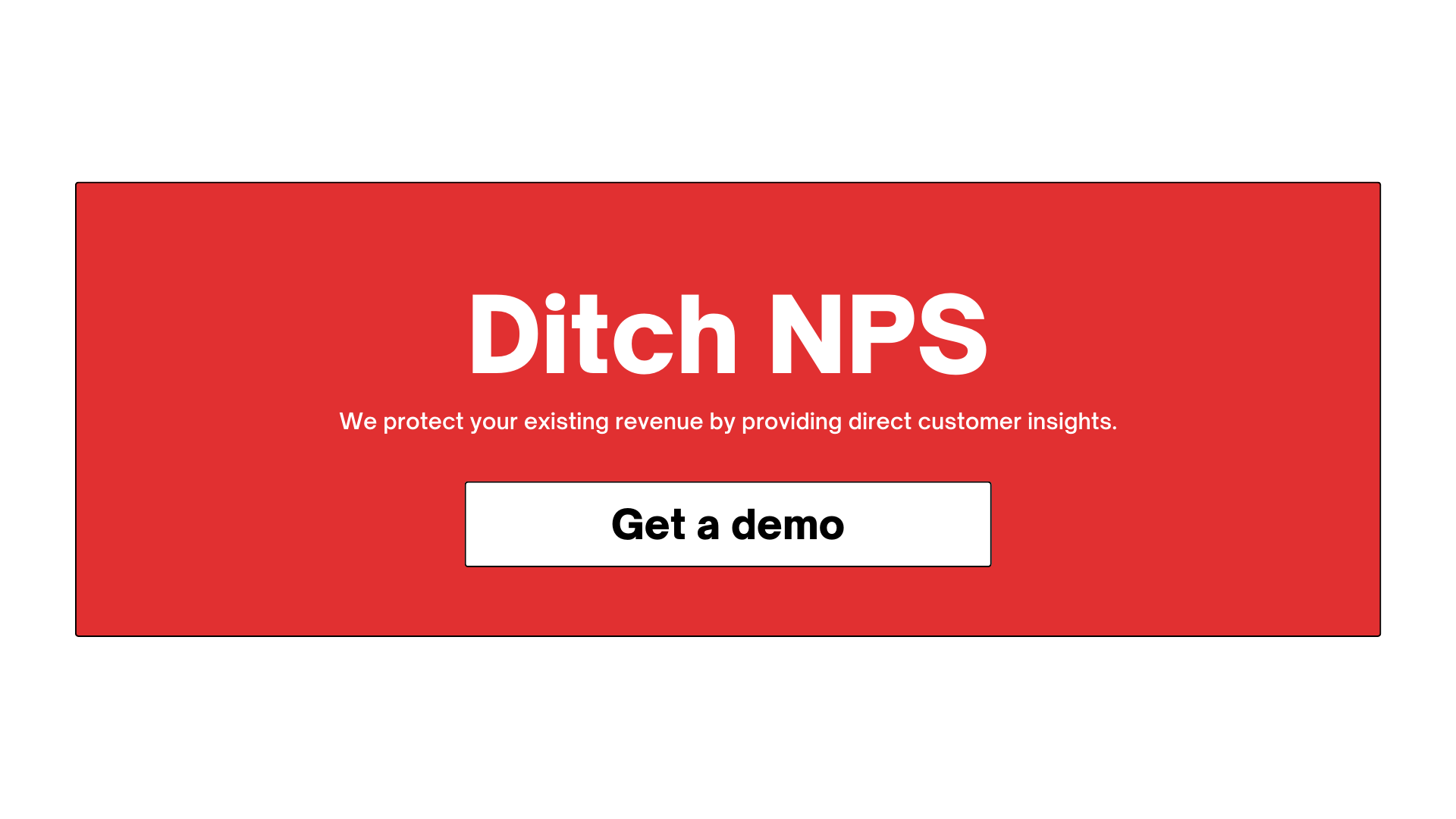When there are too many customers per CSM, the smallest customers suffer from a lack of attention. The solution for many modern Customer Success teams is to create a low-touch engagement model (sometimes referred to as Pooled CSM).
But the low-touch experience—a hybrid engagement model that’s both digitally-led while still offering access to a proactive CSM—requires different technologies, skills, processes, and goals to provide a great experience to customers.
Done well, it’s a powerful and proactive experience. Done poorly, it’s really just Customer Support Plus (or worse, a graveyard where small customers go to slowly wither until they churn).
This post covers the foundational parts of building an effective low-touch model:
- The landscape of the different engagement models,
- How to level up the maturity of your low-touch model,
- Skills needed to build an effective low-touch team, and
- A framework for deciding whether this model is right for your company.
Thank you to everyone who contributed to this piece through interviews, feedback, and edits, including Nick Mehta, Kyle Poyar, David Sakamoto, Kristi Faltorusso, Boaz Maor, Brian LaFaille, Emilia D’Anzica, Andrew Marks, Ed Powers, Elisabeth Courland, Selena Papi, David Ginsburg, Emily Garza, Shane Correa, Steve Sanchez, Jeff Breunsbach, Kristina Valkanoff, Jason Noble, Shadavia Jones, and Shannon Dunlap.
The Engagement Model Landscape
To understand where the low-touch model fits, it’s useful to visualize the different types of engagement models on a scale from low-touch to high-touch.
On the far right, we have a human-led experience. And on the far left, a digitally-led experience.

Here’s a quick overview of each experience:
- The Tech-touch, or Automated CSM, model is a completely technology-driven customer experience that's usually used by companies with a free or very low-cost product. Think Dropbox: you may see in-app tutorials guiding you through onboarding, or emails encouraging you to engage with new features.
- The low-touch, or Pooled CSM, model enables humans to use technology to drive one-to-many communication at scale. CSMs analyze data to spot trends and proactively engage with customers.
- The “human-led” experiences are typically reserved for high-value accounts. Customers get a dedicated CSM who regularly meets with them to ensure they’re achieving their desired outcomes.
Variables that determine which engagement model to implement
Most businesses don’t need all four engagement models, so one way to think about which model(s) make sense is based on the complexity of your product(s) and the potential ARR of your customers.
Here’s a visual to help explain:

To summarize this graph:
Product Complexity
How easy it is to use the product without help from a human?
- High - Product requires extensive help to adopt and understand (ex: SalesForce)
- Med - Product isn’t fully adopted without human help (ex: Qualtrics)
- Low - Completely self-service, no humans needed (ex: Zoom)
Potential ARR
How large can customers in that segment become over time?
- High - Large growth potential, many business units, global companies
- Med - Growth potential via many more seat licenses or additional features
- Low - Minimal growth potential
When considering what model is right for your business, you may also consider how serving each segment will affect your Customer Lifetime Value (CLV), Cost to Serve (CTS), and ROI. For that exercise, Ed Powers (Principal Consultant at Service Excellence Partners) has shared this calculator (with dummy data) to help you think through different scenarios.
Moving forward, this piece will solely focus on the low-touch engagement model.
The Low-Touch Maturity Scale
Building out the team and technology to drive an effective digitally-led experience requires a significant investment. Most teams tend to incrementally mature their model over time:
- Level 1: Each customer is assigned a dedicated CSM.
- Level 2: Technology is used to automate some CSM tasks. A small group of CSMs identify signs of churn risk or opportunity growth and proactively engage with customers.
- Level 3: For companies with low-complexity products—meaning, these products are very intuitive for customers to onboard and adopt—technology is the true delivery mechanism for driving customer value and adoption.
Level 1: Dedicated CSMs
Most Customer Success teams start with a model where every customer gets a dedicated CSM.
“Level 1” has the following characteristics:
- Each customer is assigned a CSM.
- Each CSM manages up to 50 customers.
- CSMs act as a reactive resource and renewals manager for customers.
- It’s a human-led model, meaning the CSM is the primary way that customers get the information they need to adopt the product.
Benefits:
- Leveling up to a higher maturity level requires huge investments in content and automation.
- Humans are good at overcoming product deficiencies (tradeoff: it’s expensive).
- Humans doing manual work will help uncover where customers receive the most value and which parts of the experience can be automated.
Drawbacks:
- CSMs are overstretched and spend most of their time on reactive inbound requests.
- CSMs may spend the majority of their time with high potential customers, which risks leaving most other customers with little to no communication.
- Level 1 is significantly more expensive in the long-term than more mature models.
Level 2: Technology-assisted CSMs who actively drive engagement
Level 2 is possible when support systems, content, and technology have been implemented to enable a small group of CSMs to manage a large portfolio of customers.
Some of the defining characteristics of Level 2 include:
- Technology is used to drive engagement. Emails, text messages, and in-app notifications that drive onboarding or product adoption are triggered by usage trends, customer lifecycle stage, or responses to experience surveys.
- There’s a small group of CSMs that proactively engage with customers when they ping in for questions related to adopting the product, or for time-bound engagements when the CSMs identify either churn risk or growth opportunity and technology fails to move the customer.
- A larger portion of tech support questions are automatically routed to Customer Support.
Benefits:
- Customers get faster response times and better coverage on issues than in Level 1.
- Better technology and process provides space for CSMs to be more proactive in noticing usage trends and helping customers achieve their desired outcomes.
- It’s more scalable than Level 1: companies can deliver a consistent customer experience to a larger group of customers.
- Multiple specialists have the required skills to deliver a great customer experience.
Drawbacks:
- Can take a year or more to implement properly.
- Requires many rounds of iteration to create a great experience.
- Difficult to maintain automated communications as the product/team/pricing evolves.
One of the best examples of this model is from Brian Lafaille, Head of Customer Success Strategic Programs at Google (Looker). In creating his model:
- Map out all behaviors that are either early indicators of expansion or churn.
- If a customer starts showing signs of churn, send emails or videos designed to encourage them to move back to using the product.
- If their usage pattern doesn’t change, then assign a CSM for a 30-day engagement to get the customer back on track.
- If a customer is showing significant increases in monthly active users, a CSM will be assigned to understand what the customer is doing that’s led to their success.
Level 3: Fully technology-driven engagement and intervention
The third and most advanced iteration of the low-touch model is to build a digitally-led experience that proactively helps customers adopt the product. There are no 1:1 engagements between the CS team and customers. Team members behind this model are responsible for routing additional educational resources to customers when they identify signs of churn risk or growth opportunity.
Level 3 is the highest level of maturity within the low-touch model, but only companies with low product complexity are likely to pull this off. Most companies with high product complexity will go no further than Level 2, as some level of human touch is required in onboarding or adopting their product.
Here’s what Level 3 looks like in practice:
- Technology is the primary driver for helping customers achieve their desired outcomes. Technology proactively delivers the right information to customers at the right time.
- Emails, videos, and other educational materials are triggered and sent when a customer shows behaviors in the product that indicates they’re trending towards churn or have growth opportunities.
- CSMs are empowered by sophisticated tools to gain deep insights on customers’ states, actions, behaviors, and health.
- CSMs are empowered by omnichannel communications to address varying customer needs and wants (and use email as little as possible!). When automations fail to help customers adopt the product, the CSM will route additional educational materials to those customers.
- Customers are often segmented by use case, industry size, etc. to help focus the right automated messages.
- Level 3 requires the product to become easier to use, which benefits all customers.
The principal benefit of this approach is scalability. Level 3 enables companies with low product complexity to support an ever-growing customer base to achieve their desired outcomes.
Drawbacks:
- This level requires significant resources from customer marketing, renewals, and operations teams.
- Expectations need to be set with customers about their experience (there are no 1:1 CSM engagements) and why it’s beneficial for them.
- Level 3 is nearly impossible to implement without a simple, intuitive, and easy-to-use product.
Building a Low-Touch CSM Team
Since the 1:many model is primarily digitally-led, Customer Success leaders need to build teams with different skills than in 1:1 models.
Key skills to have in a low-touch team
Ignoring titles, there are six skill areas you must add to your team to build an effective low-touch team. These skills can be hired, nurtured, or borrowed from other teams.
- Operations. Implement backend systems—tools, data, automation, training—that create repeatable and scalable processes for the CS team. This is the most important skill on this list for an effective low-touch model. Without a strong operations strategy, everything else crumbles.
- Customer Advocate. Analyze data and listen to the customer to identify patterns related to product adoption, anticipate churn risk, and identify promoters. But putting product adoption and risk triggers in place isn’t enough—once a customer is identified as trending towards churn, the Customer Advocate person must know how to proactively manage those conversations.
- Content. Create content for Programs/Enablement to deploy that educates different types and stages of customers on how to adopt and get the most value out of the product.
- Programs/Enablement. Structure the education content and deploy campaigns to drive product adoption. Assist with the fundamentals of the product, then help drive usage of features and deeper adoption. The enablement person interacts with other departments (Sales, Marketing, Product, etc).
- Upsell and Cross-sell. Deploy campaigns to promote other products and services—and also reach out to customers to sell the products. It’s like a demand generation, but for existing customers (they may also do lead scoring).
- Community manager (optional). Set up and implement a strategy for engaging with customers in a peer-to-peer community. Monitor the activity in the community with weekly reporting, influence Enablement to build collateral where customers are getting stuck, engage with comments and questions in the community and routes support questions appropriately, and run newsletters that are sent to the community members.
Career paths for CSMs in a low-touch model
CSMs in a low-touch model have a unique opportunity to grow their careers in many directions. In many teams, they can move “up” within the low-touch model (from a more junior CSM to a senior CSM), they can move horizontally into serving a dedicated CSM segment, or into a more customer marketing or marketing-focused role.
For example:
- CSMs could become managers within the low-touch team.
- They could grow within the low-touch program itself. Many companies have different levels within the low-touch teams that incrementally handle larger customers for time-based engagements. This is mainly true for companies with a large number of low-touch model customers who have a wide range of contract sizes. In these cases, it makes sense to have a range of CSMs who are more senior and manage customers with greater complexity.
- They could move into a CS Analyst or CS Ops role. CSMs who show an interest in implementing and maintaining technology and creating repeatable processes across the team can move into an operations role.
- They could move into a Programs or Content role. CSMs who have an interest in content development (such as running webinars or developing Marketo/HubSpot expertise) could move into roles that create or deploy content to low-touch customers.
- Or they could become a dedicated CSM. Individuals that show real signs of growth and interest in handling change management, executive stakeholder management, up-leveling their customer communication to the C-level, and other similar skills can move to become a named (or dedicated) CSM.
In Summary
- There are two types of digitally-led models: tech-touch and low-touch (also known as the pooled CSM model). The former is completely technology-driven with no human interaction, and the latter is technology-assisted with humans monitoring data.
- Companies can mature their low-touch model by investing in technology to automate CSM tasks, allowing CSMs to analyze data and proactively route resources to customers showing signs of risk (or growth).
- Within the low-touch model, a “pooled CSM” structure is better than a dedicated CSM structure but it’s expensive and time-consuming to implement.
- There are six skills you need to have in your low-touch CSM team that you currently do not have in the “human-led” experiences.
- There are many career path opportunities for CSMs that join a low-touch team.
- And a well-designed low-touch model can be used with Strategic, Enterprise, and other customers as another way to drive engagement.
Many companies implement a low-touch model that requires CSMs to perform the role of Customer Support Representative + Renewal Manager. But that strategy ultimately leads to high churn rates and ignored customers. As companies become more sophisticated, they scale from Level 1 to Level 3 in their low-touch model, creating engaging experiences and dramatically reducing churn rates.


